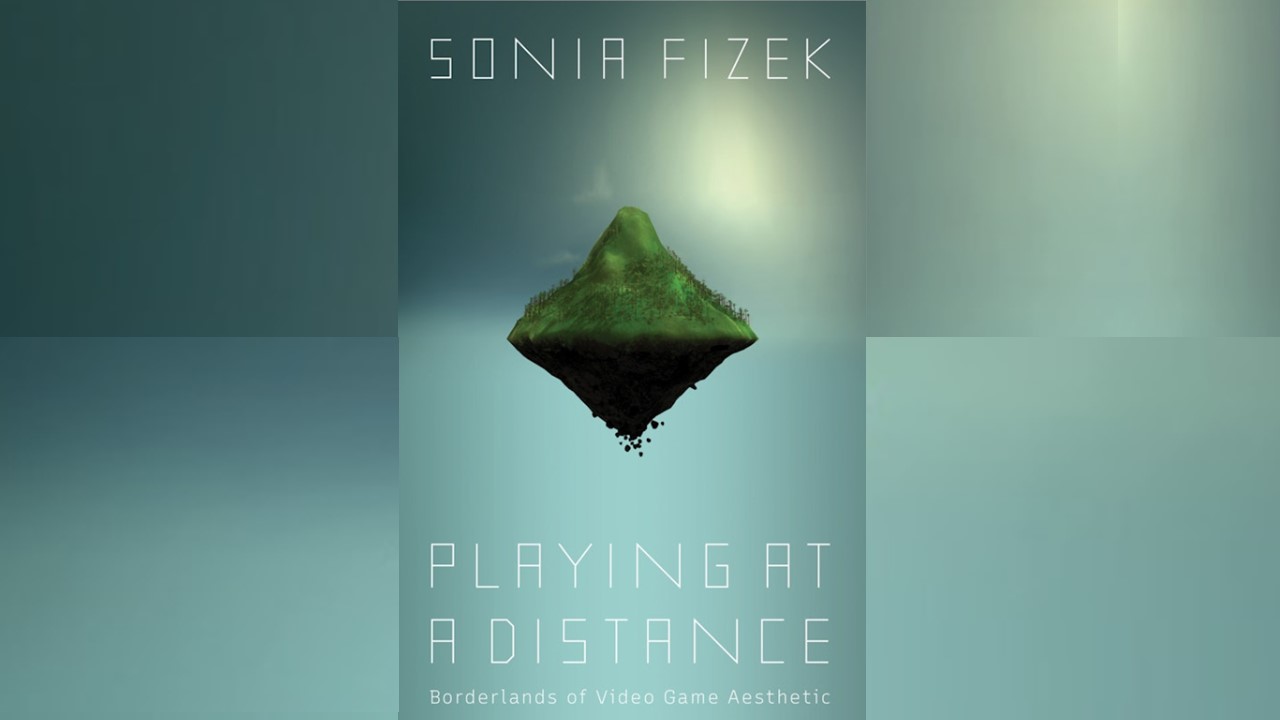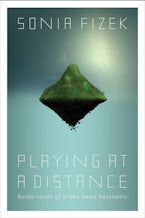
Rezension: Playing at a Distance. Borderlands of the Video Game Aesthetic

Sonia Fizek: Playing at a Distance. Borderlands of the Video Game Aesthetic. Cambridge, Massachusetts: The MIT Press November 1, 2022. 9780262544627. 186 pp., 6 x 9 in, 23 b&w illus.
The title of Sonia Fizek's work, Playing at a Distance: Borderlands of the Video Game Aesthetic, provides readers with an insight into the three main interests: Play, Distance, and Game Aesthetic. In her concentrated and extremely detailed work Fizek provides a reconceptualization of what it means to play video games by paying attention to distance as a mode of encounter with, and aesthetic experience of video games. Through her focus, she aims to problematize notions of video game play that consider the player the singular agential subject of processes of play, instead forwarding her understanding of machines, and especially code, as a "co-agent at play" (p. 103).
Consequently, Fizek frames her examination focus ‘play’ as "neither a human nor a nonhuman act" (p. XVI). Her considerations culminate in understanding computer games as mediated play as "play at a distance or dis-play" (p. XVII). For her, 'dis-play' involves being one of many agents in a distributed algorithmic entanglement, whereas playing at a distance refers to the medium-centric, posthumanist, and performative perspective, at the center of which are not only the human players as agents, but the manifestation of the game on the screen is ultimately a "representational image of multiple agencies" (p. XVII). Therefore, it is not only people who play, but also computers that play with people.
The concept distance serves as a media-aesthetic framework (see p. X) for Fizek’s study (see p. X) It provides a lens through which peripheral forms of play, often considered 'non-game' or 'non-games', can be understood in relation to the broader play landscape. Fizek’s point is that concepts such as participation, interaction, ergodicity, and human agency all variously reflect the reduction of mediated distance. This reduction in distance does not result solely from immersion, but "out of a delicate balance between action and inaction" (p. XI). According to Fizek, media are often seen as forces to shorten distance, but at the same time they produce methods of analysis "which introduce distance into the cognitive process of analysis" (p. XIII). Distance thus shows a media paradox.
She differentiates her three main interest points of investigation (play, distance, and aesthetics) into numerous other phenomena. The six chapters, in which she evolves these observations, interweave interdisciplinary approaches from media theories, philosophy, game theory, computational observations, game analytics, cultural studies, and film studies. This approach aims to enable a "situated, performative, and, most crucially, a mediated reading of play" (p. XXI).
In chapter 1 Beyond Interactivity Fizek argues that the concept of interactivity, although leading in analyzing especially games, fails to incorporate all the forms of play. While interactivity is an “extremely operational and thus hypermasculine perspective” (p. 14), analyzing play under this point of view would mean to think in the old paradigms. She suggests using other possibilities to frame the engagement with and within the world of play.
Fizek explores this suggested approach in chapter 2 Interpassive Play focusing on Idling as a ludic phenomenon using the theoretical approaches of Robert Pfaller und Slavoj Žižek. Her examples of games tend to come from a peripheral sector in which little or no "close action from the human players" is required (p. X), for instance clicker games (e. g. Cow Clicker), (life or history) simulations (e. g. the Emissary trilogy) or games which do not demand player’s action (e. g. Progress Quest). She concludes that interpassive play offers a lens to a deeper understanding of activity, passivity, the pleasure of gaming, and the role of the player (see p. 29).
In chapter 3 she takes another main focal point into account: Ambient Play. Play in general–according to Fizek–cannot be understood without including its "ambient–pervasive and all-surrounding–character" (p. 35) or recognizing a different type of aesthetics. Fizek highlights the form of playful engagement with background systems, emphasizing distant and ambient play over intense involvement. Considering the two dimensions of Ambient Play–the computational aspect and the affective part–she positions the gaming culture in a larger media landscape dealing with ambience in its numerous forms.
In chapter 4, dealing with Automated Play, Fizek postulates that without complete absorption, play can become a distracting habit that is integrated into everyday routines without taking up too much time or demanding special skills (p. 62). Within the framework of Automated Play the “human player resides outside of the interaction loop. The only role they can fill is that of an observer and interpreter of an automated systemic spectacle" (p. 52). This insight leads Fizek to a possibility of new ways of understanding the human-machine relationships which are–in the words of Karen Barad–entangled agential forces.
In chapter 5 Intra-active Play Fizek draws her observations on the basis of agential realism and especially Karen Barad's philosophy, criticizing the Cartesian dualism—or as Fizek puts it: the Cartesian trap (see p. 69). She proposes abandoning the idea of a firm distinction between the internal mind and external matter, and thereby moving away from interaction towards intra-action. In her opinion, play should be understood as an “entanglement of human and nonhuman forces” (p. 82).
This entanglement is deeper addressed by Fizek in chapter 6 Spectated Play while focusing on the video game as an algorithmic spectacle. Fizek by no means ignores the distance between computational aesthetics and sense-based human perception, but rather uses the term spectacle to try to establish a fruitful relationship between the two (p. 104). With reference to Vilém Flusser and Harun Farocki, Fizek characterizes the inherent paradox: The algorithmic spectacle creates a distance between the players and the object of the game; at the same time, spectating is a form of engagement with video games without active physical participation. Her proposal is to encapsulate the understanding of game within a meta-ontology which should be capable to describe and address the „open-ended messiness of play“ (p. 82).
Fizek acknowledges that she incorporates multiple theoretical approaches, as indicated by the disclaimer on page 17. Her observation in chapter 1 that the text may be challenging to read is also consistent with this approach. Her publication may be challenging for beginners in this particular field of study simply due to the abundance of information and theoretical approaches. Additionally, her detailed descriptions, while helpful in illustrating the theory, can make it difficult to follow the argumentation.
In this context, it is worth noting that the modular structure of the work reinforces the impression of a collection of theories. The work serves as an annotated, critical contextualization of individual approaches under the triad of play, distance, and aesthetics. However, readers who are new to these subject areas may find it challenging to navigate Fizek's work without clearer guidance. Here, it could have helped to include parts of the endnotes’ information within the text.
Fizek's posthumanist approach considers the computer as a co-agent of play. She uses physical or technical metaphors, particularly in her references to the theories of Albert Einstein or Niels Bohr. However, these references are mostly vague, which detracts from the clarity of her argument. For instance, when she argues that the nature of play cannot be firmly defined: "Play, then, is a bit like an unruly electron that keeps escaping its fixed position. Theoretical explanations can barely pin it down" (p. 79). The same accounts for her wordplay which sometimes is struggling to make sense of and finding the distinction between the given terms, for instance ‘displayed’ and ‘dis-play’.
Chapter 6 appears to be the most challenging one to read because of the complex connection between the problematization of the image itself and the computational image. It seemed like an appendix to emphasize once again that the approach moves away from the human-centric perspective (see p. 104). Additionally, the reader is left with the question of whether it is generally possible to analyze the background processes because people can only see the image and not the code behind it–therefore, this chapter appears to be a prospect for further research.
However, Fizek's work is noteworthy for its detailed and complex theoretical explanations. With over 50 examples presented in approximately 100 pages, the argumentation is guaranteed to be visualized. The author's call for a re-evaluation of seemingly self-evident concepts, such as interactivity, and their work on marginalized forms of play provide interesting impulses for further research. Fizek's study offers a thoughtful insight into the diverse ludic interweavings of play, distance, and aesthetics. She presents a variety of interdisciplinary and postmodern approaches in a concise manner.
